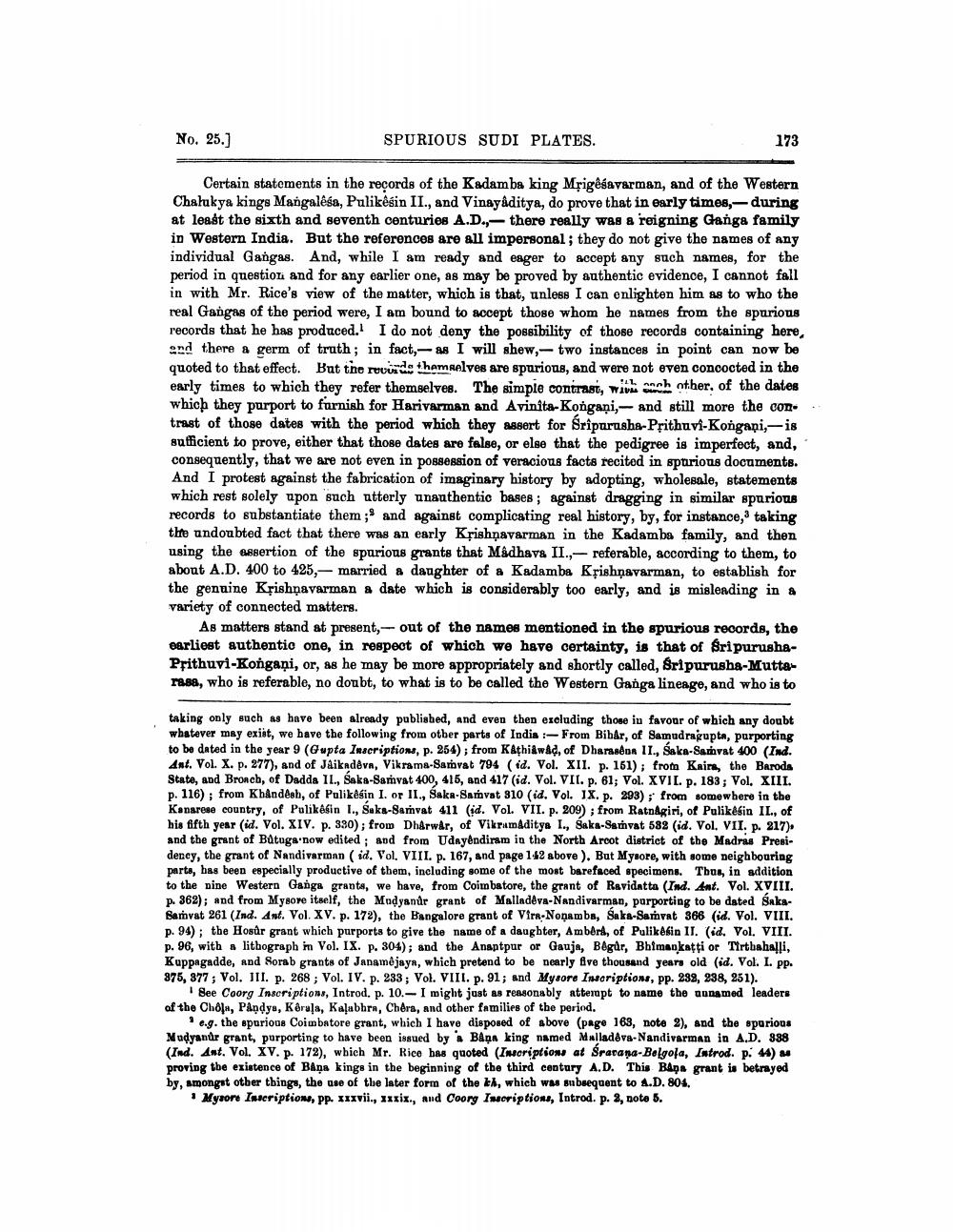________________
No. 25.)
SPURIOUS SUDI PLATES.
173
Certain statements in the records of the Kadamba king Mrigésavarman, and of the Western Chalukya kings Mangalėsa, Pulikesin II., and Vinayaditya, do prove that in early times,- during at least the sixth and seventh centuries A.D.,- there really was a reigning Ganga family in Western India. But the references are all impersonal; they do not give the names of any individual Gangas. And, while I am ready and eager to accept any such names, for the period in question and for any earlier one, as may be proved by authentic evidence, I cannot fall in with Mr. Rice's view of the matter, which is that, unless I can enlighten him as to who the real Gangas of the period were, I am bound to accept those whom he names from the spurious records that he has produced. I do not deny the possibility of those records containing here, and there a germ of truth; in fact, as I will shew,- two instances in point can now be quoted to that effect. But the rounds themselves are spurious, and were not even concocted in the early times to which they refer themselves. The simple contrast, with ach other of the dates which they purport to furnish for Harivarman and Avinita-Kongani,- and still more the con.. trast of those dates with the period which they assert for Sriparusha-Prithuvi-Kongani,- is sufficient to prove, either that those dates are false, or else that the pedigree is imperfect, and, consequently, that we are not even in possession of veracious facts recited in spurious documents. And I protest against the fabrication of imaginary history by adopting, wholesale, statements which rest solely upon such utterly unauthentic bases ; against dragging in similar spurious records to substantiate them; and against complicating real history, by, for instance, taking the undoubted fact that there was an early Krishnavarman in the Kadamba family, and then using the assertion of the spurious grants that Madhava II., - referable, according to them, to about A.D. 400 to 425,- married a daughter of a Kadamba Krishnavarman, to establish for the genuine Krishnavarman a date which is considerably too early, and is misleading in a variety of connected matters.
As matters stand at present, out of the names mentioned in the spurious records, the earliest authentic one, in respect of which we have certainty, is that of SripurushaPfithuvi-Kongani, or, as he may be more appropriately and shortly called, Sripurusha-Muttarasa, who is referable, no doubt, to what is to be called the Western Ganga lineage, and who is to
taking only such as have been already published, and even then excluding those in favour of which any doubt whatever may exist, we have the following from other parts of India - From Bibar, of Samudragupta, purporting to be dated in the year 9 (@wpta Inscriptions, p. 254), from KÄthiawad, of Dharaadon II., Saka-Samvat 400 (Ind. Ant. Vol. X. p. 277), and of Jaikadeva, Vikrama-Samovat 794 (id. Vol. XII. p. 161) : from Kairs, the Baroda State, and Bronch, of Dadda II., Saka-Samvat 400, 415, and 417 (id. Vol. VII. p. 61; Vol. XVII. p. 183; Vol. XIII. p. 116); from Khandesh, of Pulikesin I. or II, Suka-Samvat 910 (id. Vol. IX. p. 293) ;from somewhere in the Kanarese country, of Palikesin I., Suka-Samvat 411 (id. Vol. VII. p. 209); from Ratnagiri, of Pulikesin II., of his fifth year (id. Vol. XIV. p. 380); from Dharwar, of Vikramaditya I., Saka-Samvat 582 (id. Vol. VII. p. 217). and the grant of Batuga now edited ; and from Udayêndiram in the North Arcot district of the Madras Presideney, the grant of Nandivarman ( id. Vol. VIII. p. 167, and page 142 above). But Mysore, with some neighbouring parts, has been especially productive of them, including some of the most barefaced specimens. Thus, in addition to the pine Western Ganga grants, we have, from Coimbatore, the grant of Ravidatta (Ind. Ant. Vol. XVIII. p. 362); and from Mysore itself, the Modyandr grant of Malladeva-Nandivarman, purporting to be dated SakaSamvat 261 (Ind. Ant. Vol. XV. p. 172), the Bangalore grant of Virr-Noņambe, Saka-Samvat 366 (id. Vol. VIII. p. 94); the Hosûr grant which purports to give the name of a daughter, Ambra, of Pulikesin II. (id. Vol. VIII. p. 96, with a lithograph in Vol. IX. p. 304); and the Anaptpur or Gauja, Begur, Bhimaokatti or Tirthahalli, Kuppagadde, And Sorab grants of Janamêjaya, which pretend to be nearly five thousand years old (id. Vol. . pp. 875, 377; Vol. II. p. 268 ; Vol. IV. p. 233; Vol. VIII. p. 91; and Mysore Incriptions, pp. 288, 238, 251).
See Coorg Inscriptions, Introd. p. 10. - I might just as reasonably attemapt to name the aungmed leaders of the Chola, Pandya, Koraļa, Kalabhra, Chera, and other families of the period.
e.g. the spurious Coimbatore grant, which I have disposed of above (page 163, note 2), and the sparious Mudyanur grant, purporting to have been issued by Baņa king named Malladôve-Nandivarman in A.D. 988 (Ind. Ant. Vol. XV. p. 172), which Mr. Rice has quoted (Inscriptions at Sravana-Belgola, Introd. p. 44) proving the existence of Bana kinge in the beginning of the third century A.D. This Baņa grant is betrayed by, amongst other things, the use of the later form of the kh, which was subsequent to A.D. 804.
Mysore Inscriptions, PP. xxxvii., xxix., and Coorg Inscriptions, Introd. p. 2, note 5.




